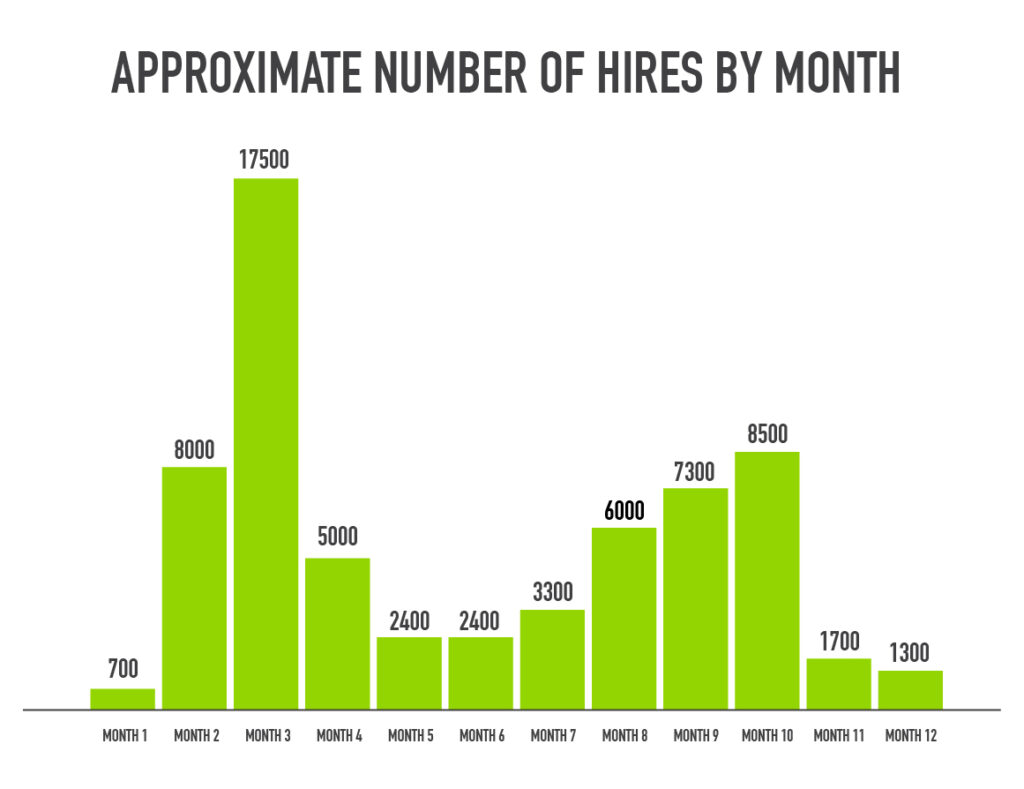In the ever-evolving landscape of talent acquisition, recruitment process outsourcing (RPO) has emerged as a go-to solution to help organizations redefine their recruitment strategies. However, many employers shy away from engaging an RPO provider because of common misperceptions. If you’re a talent acquisition leader stepping into the world of RPO for the first time, get ready to separate fact from fiction as we dismantle RPO myths.
Myth 1: Outsourcing Means Losing Control Over the Hiring Process.
Let’s set the record straight from the get-go: RPO doesn’t mean relinquishing control. You’re not sending your recruitment program into a mysterious void.
In fact, reputable RPO providers thrive on collaboration. You maintain oversight, make strategic decisions and keep your finger on the pulse of the recruitment process. Your RPO partner should provide you with regular reports so you can track metrics and SLAs against your hiring goals.
It’s like having a co-pilot who respects your position in the driver’s seat.
Myth 2: RPO is Expensive.
There’s a notion that RPO will drain your coffers faster than you can say “ROI.”
With an ever-widening skills gap and climbing hiring costs, organizations are looking for recruitment solutions to reduce overhead and improve outcomes while reducing risk. By streamlining your hiring process, reducing time-to-fill and minimizing administrative burdens, RPO creates substantial value, particularly for high-volume or hard-to-fill specialty roles. While RPO may not be the cheapest option, a good RPO, and the technology they bring to the table, improves efficiency and delivers results.
Think of it as an investment that not only bolsters your team but also your bottom line.
Myth 3: RPO Only Works for Large Companies.
You might be thinking, “RPO? That’s only for the large enterprises with deep pockets.”
Not so fast! RPO isn’t an exclusive club for corporate giants. It’s an adaptable strategy for businesses of all sizes. Whether you’re a startup looking to scale or a mid-sized enterprise seeking an edge, RPO can be tailored to fit your unique needs.
In fact, according to Everest Group, smaller organizations made up 43% of RPO of news deals in 2022, up from 23% in 2017, as they increasingly turn to RPO to help scale and reduce risk in an uncertain labor market. RPO helps these mid-sized and small organizations scale up their hiring efforts without the costly commitment of building talent acquisition teams in-house.
Myth 4: RPO Takes a Long Time to Implement.
With the economy see-sawing post-pandemic, we’ve seen our clients shift their focus to agility and speed with an increase in urgent hiring projects. Organizations often think that RPO is not a viable option in these situations due to the misperception that it takes 12 to 16 weeks to ramp up.
While an RPO engagement can certainly be a long-term strategic partnership, there are also solutions for short-term recruitment projects where speed is the priority. For example, we developed PeopleScout Accelerate, a tech-powered, ready-to-go recruitment process outsourcing (RPO) solution that combines PeopleScout’s deep recruitment expertise and a pre-configured Affinix® talent acquisition technology suite—implemented in just two weeks.
Myth 5: RPO is Only for Filling Volume-Based Positions.
Your talent needs are unique to your organization and the right RPO partner will know that a one-size-fits-approach isn’t effective. Don’t let the myth of “volume hiring only” keep you from experiencing the benefits of RPO.
While RPO is an ideal solution for high-volume hiring in which many hires for similar job families are made annually, it’s also perfect for hard-to-fill specialist professional roles. With their networks, resources and expertise, RPOs have the ability to attract candidates from all corners of your industry.
One huge bonus of the long-term relationship you build with an RPO partner is their ability to create talent pools. Having a pool of active and passive candidates speeds up time-to-hire by giving you fast access to qualified candidates when a new vacancy opens. Plus, RPO providers have access to leading technology featuring AI matching tools that can identify and source strong passive and active candidates within seconds of an open job requisition.
Myth 6: RPO is Exclusively Cost-Cutting, Not Quality-Improving.
Quality over quantity, right? Absolutely. And guess what? RPO providers are on the same page.
Unlike working with a staffing agency, which is often a transactional relationship, an RPO partner won’t flood your inbox with résumés that miss the mark. Instead, they use targeted strategies to find the ideal candidate who aligns with your values and vision.
RPO providers can help you develop and implement effective selection and assessment processes to identify high-performing candidates with the right skills and experience for the role. Plus, with their tech know-how, RPOs can help you leverage predictive analytics to gain a better understanding of the behaviors of top talent and predict factors such as cultural fit, willingness to change companies and future tenure potential.
With RPO, quality isn’t compromised—it’s elevated.
Myth 7: RPO is a One-Size-Fits-All Solution.
While some providers have gained reputations for making their clients follow a rigid process, it doesn’t have to be this way.
Good RPO partners are chameleons, adjusting their approach to your shifting hiring needs. Whether you’re gearing up for a hiring spree or scaling down temporarily, your RPO provider should deliver custom solutions based on your industry, job types, hiring budget and goals.
And remember, you don’t have to outsource your entire full-cycle, end-to-end recruitment process. Look for an RPO partner that offers partial-cycle, project-based and even modular RPO solutions to help you scale your recruitment function to meet your needs—from talent mapping and sourcing to designing assessments and onboarding. In the fast-paced world of talent acquisition, flexibility is your secret weapon. An RPO partner should provide you with the agility you need to weather the ups and downs of the economy.
Myth 8: RPO Providers Only Cover Recruitment.
While RPO is focused on improving recruitment processes, it can also include other HR functions such as employer branding, talent management and workforce planning. RPO providers can offer a range of services that can be customized to meet the specific needs of the organization.
RPO partners are increasingly offering a range of value-added services to meet the demand for proactive, innovative candidate experiences. When you partner with a leading RPO provider, you also access:
- Talent acquisition consulting and best practices
- Technology consulting and implementation
- Passive candidate engagement
- Market insights, talent mapping and analytics
- Recruitment marketing and candidate attraction strategies
- Employer branding and employer value proposition (EVP) development
- Assessment design and execution
- Diversity, equity and inclusion consulting
When considering potential RPO providers, make sure they can provide you with value-added services that will optimize and streamline each phase of the recruiting process.
Myth 9: RPO Replaces Your Internal HR Expertise.
Your internal talent acquisition expertise is invaluable—and it’s here to stay. RPO isn’t about replacing your team; it’s about augmenting their strengths.
Organizations often struggle to invest in growing the number of talent acquisition and HR resources required to keep up with the rate of change. RPO providers take on time-consuming, but necessary, recruiting activities such as sourcing and candidate engagement. This frees up internal HR staff to focus on higher value activities.
Plus, through working across many clients and industries, RPOs have their finger on the pulse of what’s going on the labor market and can share best practices and insights to help you make informed workforce decisions.
Consider your RPO team your ally, enhancing your internal capabilities and helping you and your team shine even brighter.
Myth 10: RPOs Don’t Care About Your Company Culture.
Your company culture is your crown jewel, and you’re not about to let it fade away in the name of outsourcing. Fear not! Reputable RPO providers understand the value of cultural fit.
Your RPO team integrates your values, purpose and employer brand into every candidate touchpoint. An RPO provider can help you amplify your employer brand by leveraging your established candidate attraction assets in targeted recruitment marketing campaigns. Utilizing job postings, social media posts, your career site and email campaigns, your RPO provider will carry your carefully crafted employer brand to candidates, providing them with compelling reason apply to your open positions.
It’s like having a partner who not only respects your company culture but actively works to preserve and enhance it.
If your organization is looking to develop an employer brand from scratch or update your current one, a leading RPO partner can provide you with employer branding services to complement your recruitment strategy ranging from creative support to full-scale employer value propositions (EVP) development.
From debunking misconceptions to revealing the true essence of RPO, you’ve now navigated through the labyrinth of misperceptions to arrive at the threshold of transformation. With RPO, you’re not just recruiting—you’re building a workforce that will grow your business for years to come. So, it’s time to shatter RPO myths and embrace the potential of of this powerhouse solution.
You might also be interested in:



